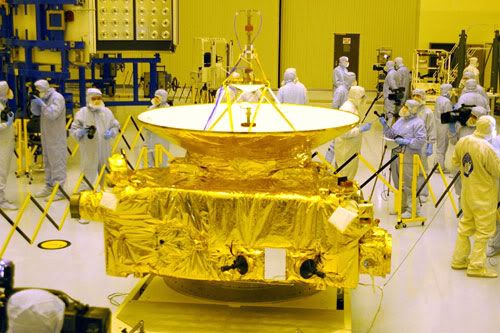
New Horizons Space Probe
Nearly 3 billion miles away, a space probe awakes
NASA's New Horizons space probe has successfully woken up from hibernation as it closes in on Pluto and its satellites.
Sen—NASA’s fastest space probe ever launched to the outer Solar System,New Horizons, has woken successfully from hibernation as it closes in on target Pluto.
Mission controllers confirmed early today that the spacecraft had switched to active mode, in preparation for its fly past the former planet and its moons on 14 July, 2015.
It took four hours and 26 minutes for the signal to travel more than 2.9 billion miles (4.7 billion km) back to Earth to confirm that the probe was alive. It was picked up by NASA’s Deep Space Network station in Canberra, Australia.
Recommended: Are you scientifically literate? Take our quiz
After a nine year voyage, this is the farthest any space mission has traveled to reach its primary target.
Operators at the Johns Hopkins University Applied Physics Laboratory confirmed at 9:53 p.m. (EST) ) 02:53 (UTC) that New Horizons, had switched from hibernation to active mode, as its pre-programmed computer commands instructed.
Alan Stern, New Horizons principal investigator from Southwest Research Institute, commented: “This is a watershed event that signals the end of New Horizons crossing of a vast ocean of space to the very frontier of our Solar System, and the beginning of the mission’s primary objective: the exploration of Pluto and its many moons in 2015.”
Launched on January 19, 2006, New Horizons has spent about two-thirds of its flight time, 1,873 days, in hibernation. Its 18 separate hibernation periods, from mid-2007 to late 2014, ranged from 36 days to 202 days in length.
During hibernation mode, much of the New Horizons spacecraft was unpowered. The onboard flight computer monitored system health and broadcast a weekly beacon-status tone back to Earth.
The wake-up sequence started aboard the spacecraft at 3 p.m. EST (08:00 UTC) on 6 December. About 90 minutes later, New Horizons began transmitting word to Earth on its condition, including the report that it is back in active mode.
As part of the wake-up, NASA broadcast a special version of Where My Heart Will Take Me, by English tenor Russell Watson, which included a greeting to New Horizons from the singer.
The next few weeks will be used to check that the spacecraft's systems and science instruments are operating properly, and to build and test the computer-command sequences that will guide New Horizons through its flight to and reconnaissance of the Pluto system.
The seven-instrument science payload includes advanced imaging infrared and ultraviolet spectrometers, a compact multicolor camera, a high-resolution telescopic camera, two powerful particle spectrometers and a space-dust detector. New Horizons will begin observing the Pluto system on 15 January. Closest approach to Pluto will occur on 14 July.
“New Horizons is on a journey to a new class of planets we’ve never seen, in a place we’ve never been before,” said New Horizons Project Scientist Hal Weaver, of APL. “For decades we thought Pluto was this odd little body on the planetary outskirts; now we know it’s really a gateway to an entire region of new worlds in the Kuiper Belt, and New Horizons is going to provide the first close-up look at them.”
Related Links:

No comments:
Post a Comment